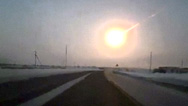Hunting Meteorites
- Posted 09.01.06
- NOVA scienceNOW
Fortunately, asteroids as huge as the one thought to have knocked out the dinosaurs don't hit Earth every day. But a surprising number of smaller rocks do. In this video clip, meteorite hunter Rob Matson invites NOVA scienceNOW host Neil deGrasse Tyson to the Mojave Desert to see for himself.
Transcript
Hunting Meteorites
Posted: September 1, 2006
NARRATOR: Luckily for us, asteroids as huge as the one that knocked out the dinosaurs don't hit Earth everyday. But a surprising number of smaller rocks do. Meteorite hunter Rob Matson invited NOVA scienceNOW host Neil deGrasse Tyson to the Mojave Desert to see for himself.
NEIL deGRASSE TYSON: So what is this place you dragged me to here? What do you do here?
ROB MATSON: Out in the middle of nowhere?
NEIL deGRASSE TYSON: Yeah, yeah
ROB MATSON: This is Coyote Dry Lake. It's a placetecine lake that drained and meteorites have been collecting here for 14,000 years. Meteorites fall all over the Earth, they fall in the oceans, and they fall in your backyard. But you have a lot of distracting things to make it difficult. But you come out here and meteorites should stand out like a sore thumb.
NEIL deGRASSE TYSON: Do you have any on you right now?
ROB MATSON: I do indeed
NEIL deGRASSE TYSON: What do you have? Is it metallic or rocky?
ROB MATSON: This is a stony meteorite.
NEIL deGRASSE TYSON: So I see it has the fusion crust still on it there.
ROB MATSON: Nice black crust on it, yeah. It forms a crust from the heat of entry through the atmosphere. And you can see it is already rusting. Meteorites don't like being on Earth, cause we have oxygen and water and iron doesn't do well.
NEIL deGRASSE TYSON: So they can go a billion years in space and then come to Earth and just corrode.
ROB MATSON: And then they'll rust, and corrode, and they don't have very long lifetimes.
NEIL deGRASSE TYSON: So you brought a refrigerator magnet?
ROB MATSON: I brought a magnet, and you can see it sticks pretty well.
NEIL deGRASSE TYSON: Whoa. So how many meteorites, how long have you been looking, and how many have you found?
ROB MATSON: I found my first meteorite here, five years ago, yesterday.
NEIL deGRASSE TYSON: OK
ROB MATSON: So I have been searching here for a while. This wasn't the first location where I found a meteorite, but here on this lakebed I found twenty-three.
NEIL deGRASSE TYSON: Twenty-three meteorites, and you know how much area you'd covered.
ROB MATSON: Right
NEIL deGRASSE TYSON: And we know how old the lakebed is, and we presume that meteorites are falling everywhere on Earth, so you ought to be able to calculate.
ROB MATSON: Exactly right, we know the area of the lake, we can count how many meteorites we've found. In our very detailed grid searching, we'd like to think we haven't missed anything, which of course, isn't true, we've missed a few things. But we can set a lower limit by extrapolating the area of this lake to the whole Earth.
NEIL deGRASSE TYSON: And what do you get?
ROB MATSON: We get about 20 to 40 thousand meteorites a year.
NEIL deGRASSE TYSON: Hitting the Earth?
ROB MATSON: Hitting the Earth. Sounds like a lot but the Earth is big. So, any one square mile might see a meteorite every thousand years.
NEIL deGRASSE TYSON: So when you just spot a rock, do you know just at a glance the likelihood that it will be a meteorite? Or are you checking every single rock that you see?
ROB MATSON: No. Most of the ones that you'll see out here they'll have the wrong color, or they'll have the wrong texture on the outside.
NEIL deGRASSE TYSON: So you don't even bend down to touch those.
ROB MATSON: Yeah, you're bending down enough, picking up enough rocks during the day. You like to avoid that as much as possible, your back gets a little sore.
NEIL deGRASSE TYSON: OK so it helps to know a little bit in advance,
ROB MATSON: Like a rock like this, its gray, it's not likely to be a meteorite,
NEIL deGRASSE TYSON: I am going to bend down, cause I haven't done this much.
ROB MATSON: Notice it is a little bit purple, its another color that tells you its not going to be a meteorite.
NEIL deGRASSE TYSON: Throw it back. And I got another one here, another purple rock. It clearly is different in character, in structure and density from the other ones you've showed me. So I just throw it back.
ROB MATSON: We call it a leaverite. Leave her right there.
NEIL deGRASSE TYSON: Leave her right there, ok.
ROB MATSON: The other term we have is called meteor-wrong. That is reserved for a rock that is ruled promising, and you pick it up and it ought to be a meteorite and then you see it up close.
NEIL deGRASSE TYSON: And it is a meteor-wrong.
Related Links
-

Meteor Strike
A meteor burst into a fireball over Siberia. Can we spot the next deadly asteroid in time?
-

Asteroid
Will a doomsday rock the size of the Rose Bowl hit Earth in 2036?
-

Asteroid: Expert Q&A
NASA's Don Yeomans answers questions about Apophis and the asteroid threat in general.
-

The Asteroid That Hit L.A.
Use a catastrophe calculator to try out some "what-if" scenarios regarding an asteroid potentially striking Los Angeles.



